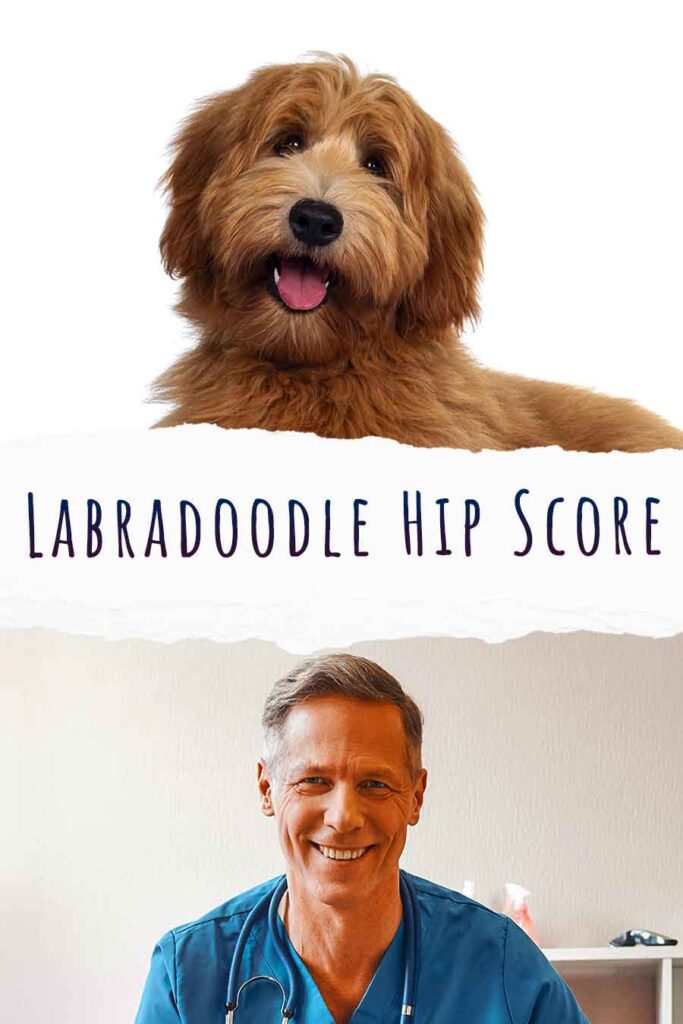In this complete guide to understanding a Labradoodle hip score, we explore why hip scores are so important for mixed breed dogs, and how to recognize a good one.
‘Labradoodle hip score’ can refer to the hip scores of a Labradoodle puppies’ parents. Or it can mean an adult Labradoodle’s hip score, if they are being considered as a breeding dog. In either case, good or excellent hips scores can protect you from a lifetime of heartache and expensive veterinary care. Finally, it can be the measure of dysplasia in a Labradoodle with a hip dysplasia diagnosis.
What Is A Labradoodle Hip Score?
Hip scores measure the degree of hip dysplasia in a dog’s hip joint. Different countries have different systems for measuring hip dysplasia. In America, the most commonly used system is the Orthopedic Foundation for Animal’s hip grading service. The OFA assigns dogs to one of seven categories, from excellent (meaning no sign of hip dysplasia), to severe (meaning severely dysplastic).
What Is Hip Dysplasia?
Hip dysplasia is a malformation of the hip joint. The hip joint is a ball and socket joint – the top of the thigh bone ends in a ball shape called the femoral head. The femoral head should fit snugly inside a socket shape in the hip bone. Hip dysplasia occurs when either the femoral head or the hip socket are misshapen, and don’t fit together well.
Because the bones don’t fit together correctly, dysplastic hip joints move too loosely. They are also likely to wear down abnormally quickly. And they are more likely to develop osteoarthritis – inflammation of the protective cartilage inside the joint, which cushions the impact from using it.
Dogs with hip dysplasia experience stiffness, discomfort and pain. They are likely to have a decreased range of movement, and avoid strenuous movement such as running, or climbing. Some dogs with hip dysplasia adopt a distinctive ‘bunny hopping’ walk, or sway their hips, to try and counteract the pain.
Hip dysplasia can be managed by:
- keeping affected dogs at a healthy weight,
- limiting exercise,
- administering anti-inflammatory medicines and pain killers,
- and sometimes through surgery.
But the cost of these can run to several thousands of dollars over the course of their lifetime.
What causes hip dysplasia?
Hip dysplasia is one of the most prevalent health problems in pet dogs. It can be acquired, hereditary, or a combination of both.
Acquired hip dysplasia can be caused by too much inappropriate exercise as a puppy. Such as leash walking on hard sidewalks, or climbing up and down stairs. These activities can damage the soft growth plates in a puppies’ joints, causing abnormal bone formation. Acquired hip dysplasia can also be the result of carrying too much excess weight, which puts strain on the whole skeleton.
Hereditary hip dysplasia is caused by faulty genes. It is thought that several faulty genes, inherited either together or singly, can increase the risk of a puppy developing hip dysplasia. And it’s this hereditary component which makes Labradoodle hip scoring so important.

Why Are Hip Scores Important?
Retrieving breeds and water breeds from the AKC working group have the highest rates of hip dysplasia. This includes both of the Labradoodle’s parents. In the USA, approximately 1 in 9 Labs have some degree of hip dysplasia, as do 1 in 8 Poodles. But, these figures represent an improvement on 50 years ago, thanks to a concerted effort by responsible breeders to only use sires and dams with good hip scores. This suggests that hip dysplasia-causing genes occur at a higher than average frequency in Labs and Poodles, but good breeding prevents them being passed on to new generations.
However, some veterinarians are worried that hip scores are perceived as only relevant to purebred dogs. So people looking for a first generation Labradoodle puppy, or considering mating their adult Labradoodle, overlook the importance of hip scores. In fact, any dog being considered for breeding should have their hips tested. This is true of a Labrador and Poodle being used to create a first generation litter of Labradoodles. And equally of a 2nd generation Labradoodle being backcrossed to a Poodle.
Insisting on hip score certificates for a Labradoodle puppy’s parents, or securing hip scores for a Labradoodle before breeding from them:
- Protects puppy’s long term health and welfare.
- Reduces the risk of heart ache and expensive treatment further down the line.
- Supports good breeding practices, and keeps money away from puppy farmers.
Where do Labradoodle Hip Scores Come From?
In the USA, the Orthopedic Foundation for Animals (OFA) assigns hip scores. Dogs must be at least two years old to allow for bone changes whilst they are still growing, and female dogs mustn’t be pregnant or in season. The dog’s usual veterinarian takes a radiograph (x-ray) of their hips under general anesthetic or heavy sedation, and these are submitted to the OFA. The images are evaluated by three independent radiologists, and each evaluator assigns them one of seven possible grades. The average of those three grades is the final result, which the dog’s owner receives on an OFA certificate. The possible grades are:
- Excellent
- Good
- Fair
- Borderline
- Mild
- Moderate
- Severe
OFA Scores vs PennHip Scores
The OFA was established in 1966 with the specific objective of reducing hip and elbow dysplasia in dogs. It is still the principal hip and elbow scoring service in America. However, OFA scores are sometimes criticized for being subjective. They’re also unsuitable for diagnosing hip dysplasia in dogs under 2 years old.
PennHip scores are an alternative hip grading system, developed in the 1990s. They can be awarded from 16 weeks old, and they are more objective than OFA scores. But they are less widely available, must be performed under general anesthetic, and cost a lot more than OFA scores.
How much is hip scoring for dogs?
The cost of OFA hip scores is a $35 fee payable to the OFA, plus the veterinarian’s fee for taking and submitting the radiographs. This is usually in the region of $250. There can be additional costs too – for example if the OFA decides the images are unsuitable, and need to be taken again. PennHip scores cost up to $600.
The cumulative cost of health clearances like hip scoring, eye tests, heart exams, etc, is why good quality puppies from responsible breeders cost a lot of money! When puppy farmers ask the same price as responsible breeders, but can’t provide certificates to prove health tests have been carried out, that is simply profiteering to get an inflated price for poor quality puppies.
What Is A Good Labradoodle Hip Score?
Excellent, good and fair scores are all considered to be within normal limits. Mild, moderate and severe scores are all dysplastic.
Approximately 1 in 5 Labrador Retrievers receive an excellent grade. And so do 1 in 8 Poodles. So, there’s little reason why Labradoodle breeders should resort to breeding litters from individuals with poor or mediocre scores. Good Labradoodle parent hips scores are ‘excellent’ and ‘good’. When you approach a breeder about a litter of Labradoodle puppies, they should be able to provide copies of the hip score certificates for both parents.
What about Australian Labradoodles?
Since the 1990s, some breeders have been working on developing Labradoodles as a purebred dog in their own right, capturing all the best qualities of a Lab and a Poodle. These are known as Australian Labradoodles. So far, approximately 1 in 7 Australian Labradoodles screened by the OFA received a dysplastic hip score, and only 1 in 10 received an excellent score.
In other words, the average Australian Labradoodle hip score is currently worse than a Labrador Retriever or Poodle’s. But individuals with excellent hips still exist. Australian Labradoodle puppies should only come from sires and dam with excellent hip scores. This way, hopefully Aussie Labradoodle hip health with improve over time, like Labradors’ and Poodles’ has.
Beyond Labradoodle Hip Scores
Hip scores aren’t the only thing to consider when researching Doodle dog pups, or breeding from a Labradoodle.
Breeding Labradors should all receive the following health clearances, at a minimum:
- elbow dysplasia
- eye disease
- and exercise induced collapse.
Poodles should also be tested for eye disease. Plus either:
- thyroid disease
- sebaceous adenitis
- or heart disease.
And finally, Australian Labradoodles should receive health clearances for:
- elbow dysplasia
- eye disease
- progressive retinal atrophy specifically
- and exercise induced collapse.
Labradoodle Hip Score Summary
Hip dysplasia is a malformation of the hip joint which causes stiffness, inflammation, and pain. Hip scores are awarded by the OFA on a scale of excellent to severe. They measure how much dysplasia a dog has in their hip joints. Labradoodle puppies should come from parents with ‘good’ or ‘excellent’ hip scores. You might also receive a hip score for your Labradoodle as part of a hip dysplasia diagnosis in later life. If you have any concerns about your Labradoodle’s hip score, consult your veterinarian.
Do you know your Labradoodle’s hip score?
Let us know in the comments box down below!
Readers Also Liked
References
Orthopedic Foundation for Animals
Ali et al. Genetic analysis of the modern Australian labradoodle dog breed reveals an excess of the poodle genome. PLoS Genetics. 2020.
Barnette. Pros and Cons of PennHip and OFA Hip Radiographs: Review for Vet Students. VetPrep. 2020.
Hou et al. Retrospective Analysis for Genetic Improvement of Hip Joints of Cohort Labrador Retrievers in the United States: 1970–2007. PLoS One. 2010.
James et al. Effectiveness of Canine Hip Dysplasia and Elbow Dysplasia Improvement Programs in Six UK Pedigree Breeds. Frontiers In Veterinary Science. 2020.
Loder & Todhunter. The Demographics of Canine Hip Dysplasia in the United States and Canada. Journal of Veterinary Medicine. 2017.
Riches-Tomei. Update on hip and elbow dysplasia schemes. Veterinary Nursing Journal. 2011.
Schachner & Lopez. Diagnosis , prevention, and management of canine hip dysplasia: a review. Veterinary Medicine: Research & Reports. 2015.

